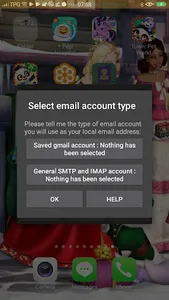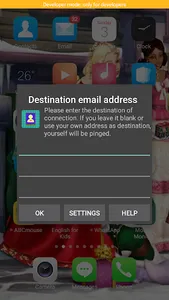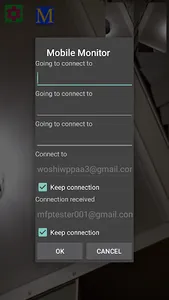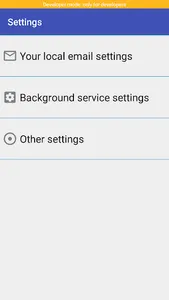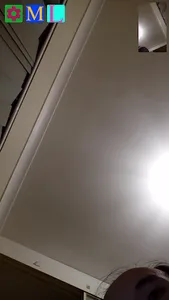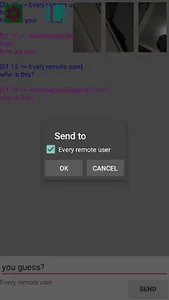P2P Remote Video supports remote peer-to-peer data, audio and video communication. It is more than a chatting tool. It can also be used as a monitor to supervise remote end thousands of kilometers away. P2P Remote Video is a genuine peer-to-peer app. There is no central server required. User only needs to know counter-party email address and then is able to connect to the counter party. The communication data stream is not transferred by server so that it is safe and swift. At this moment this functionality is still in the testing phase. Its stability and performance will be improved gradually. And it will finally become a mile stone of this app.
P2P Remote Video can send and receive text messages and video/audio streams from other (at most three) P2P Remote Video apps. It can also start automatically when a connection request comes in. As such, more than a communication tool, P2P Remote Video can play a monitor role to observe what happens in the remote side. Connection between user and remote counter-party is established by exchanging emails. Email as an agent is no longer needed after connection is ready to use. In other words, email plays a critical role as a signal channel to launch the communication.
Assume user has two Android phones both of which have P2P Remote Video installed. In order to start peer-to-peer communication, two email boxes (one for each phone) are also needed. User can choose gmail which is simple and easy to configure. Alternatively, the email boxes should:
1. support SMTP and IMAP protocols (which are supported by most email services);
2. support sending and receiving emails using general email client, like Thunderbird Mail;
3. allow email client to check incoming emails high-frequently. At this stage P2P Remote Video checks email every 15 seconds. This guarantees real-time response to incoming connection requests. Otherwise, user may wait tens of minutes for the counter party to get the connection email, which is totally unacceptable.
However, building up connection needs not to send many or large volume emails. In total, 6 emails will be exchanged and each of them is just 50~300 characters long. These emails can be deleted after the communication session finishes.
Most of prevalent email services match the above requirements. Developer has demonstrated in the manual how to set up Microsoft hotmail/outlook mail or Google gmail. In particular, Microsoft hotmail/outlook mail is highly recommended because sending and receiving emails using general email client is supported by default (i.e. no need to activate this feature).
If everything is OK, a connection will be built up in 3~5 minutes amid some messages flashing over the screen. User may find state of the connection from the messages. Then video window will be split into two. The big one shows image of user and the smaller in-frame one shows remote image. User can also talk and exchange messages. If no video connection is available after 7~8 minutes, while password, remote email address and other settings are definitely correct, user may login webmail to check if emails from counter party have been received. The title of the email should be #####AnMath#####:000068:1→s. User may also check if email(s) have been sent to the counter party. The title of the email(s) should be like #####AnMath#####:000068:0→s:0→s:0→s:0→s:0→s:0→s:0→s: . Missing some emails means the background service is not running properly. Both inbox/outbox and spam box should be inspected. And any system email should also be carefully read because it may include warning message(s) that some emails are blocked and solutions user has to take. If user cannot figure out the reason, she may contact developer at cyzsoft@gmail.com.
P2P Remote Video can send and receive text messages and video/audio streams from other (at most three) P2P Remote Video apps. It can also start automatically when a connection request comes in. As such, more than a communication tool, P2P Remote Video can play a monitor role to observe what happens in the remote side. Connection between user and remote counter-party is established by exchanging emails. Email as an agent is no longer needed after connection is ready to use. In other words, email plays a critical role as a signal channel to launch the communication.
Assume user has two Android phones both of which have P2P Remote Video installed. In order to start peer-to-peer communication, two email boxes (one for each phone) are also needed. User can choose gmail which is simple and easy to configure. Alternatively, the email boxes should:
1. support SMTP and IMAP protocols (which are supported by most email services);
2. support sending and receiving emails using general email client, like Thunderbird Mail;
3. allow email client to check incoming emails high-frequently. At this stage P2P Remote Video checks email every 15 seconds. This guarantees real-time response to incoming connection requests. Otherwise, user may wait tens of minutes for the counter party to get the connection email, which is totally unacceptable.
However, building up connection needs not to send many or large volume emails. In total, 6 emails will be exchanged and each of them is just 50~300 characters long. These emails can be deleted after the communication session finishes.
Most of prevalent email services match the above requirements. Developer has demonstrated in the manual how to set up Microsoft hotmail/outlook mail or Google gmail. In particular, Microsoft hotmail/outlook mail is highly recommended because sending and receiving emails using general email client is supported by default (i.e. no need to activate this feature).
If everything is OK, a connection will be built up in 3~5 minutes amid some messages flashing over the screen. User may find state of the connection from the messages. Then video window will be split into two. The big one shows image of user and the smaller in-frame one shows remote image. User can also talk and exchange messages. If no video connection is available after 7~8 minutes, while password, remote email address and other settings are definitely correct, user may login webmail to check if emails from counter party have been received. The title of the email should be #####AnMath#####:000068:1→s. User may also check if email(s) have been sent to the counter party. The title of the email(s) should be like #####AnMath#####:000068:0→s:0→s:0→s:0→s:0→s:0→s:0→s: . Missing some emails means the background service is not running properly. Both inbox/outbox and spam box should be inspected. And any system email should also be carefully read because it may include warning message(s) that some emails are blocked and solutions user has to take. If user cannot figure out the reason, she may contact developer at cyzsoft@gmail.com.
Show More
